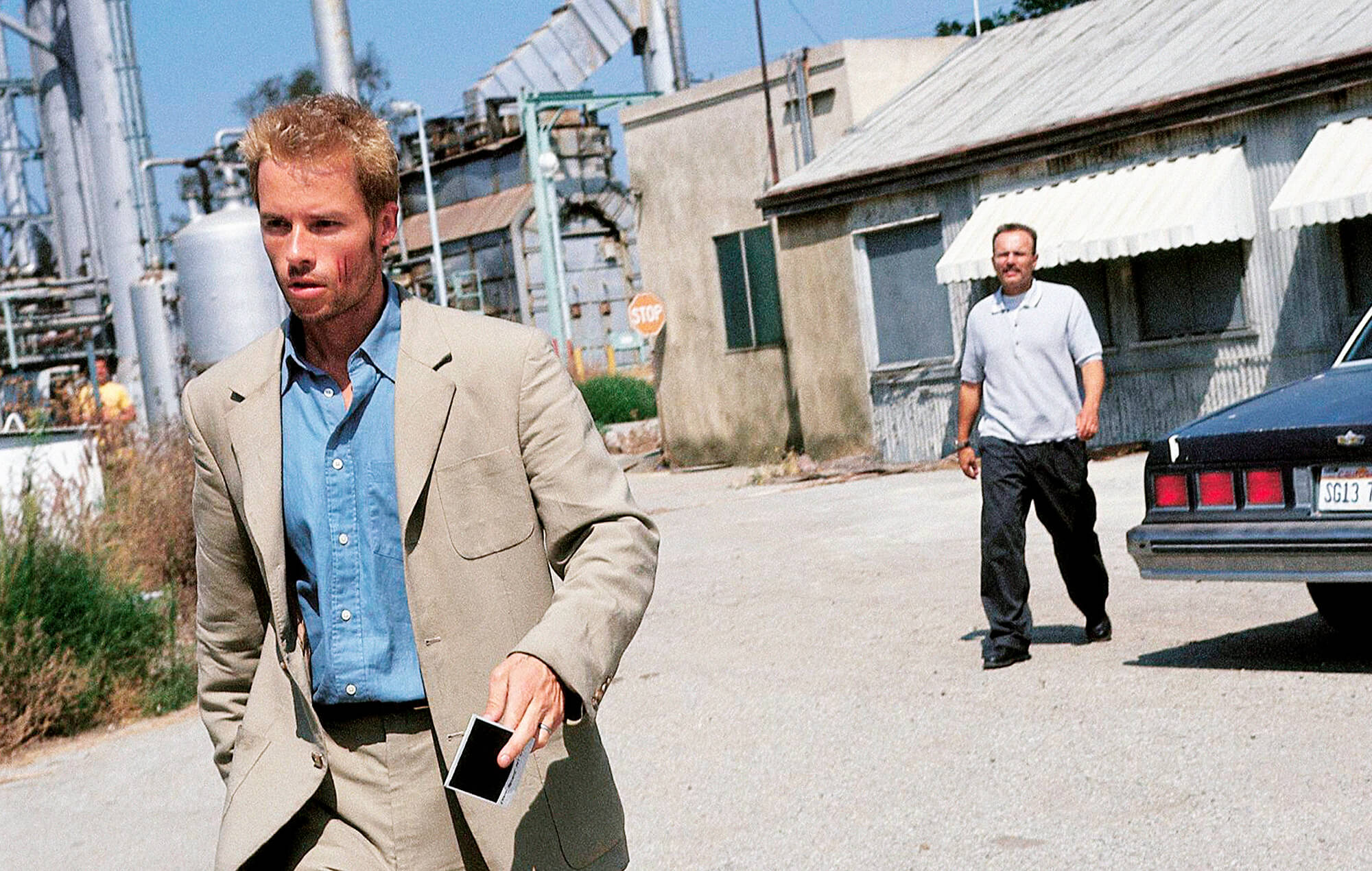Christopher Nolan’s Memento stands out for its unique storytelling approach, employing a nonlinear narrative. The film alternates between two timelines: black-and-white sequences that unfold chronologically and color scenes that move in reverse order. These timelines converge toward the film’s climax, demanding that viewers piece together the story while unraveling the mystery.
The unconventional narrative structure forces the audience to engage more deeply with the plot and maintain constant awareness of both timelines, offering a gripping cinematic experience.
The film’s protagonist, Leonard Shelby (played by Guy Pearce), suffers from anterograde amnesia, a condition that prevents him from forming new memories. His disorder causes him to forget everything that happens after a short time, leaving him in a constant state of confusion. Leonard relies on notes, photographs, and tattoos to remind himself of essential information. His main objective throughout the film is to track down the man who murdered his wife, a quest that drives his every action despite the challenge of his condition.

The Search for “John G” and Conflicting Clues
Leonard’s pursuit of his wife’s killer is fraught with confusion and contradictions. He clings to the belief that someone named “John G” or “James G” is responsible for the crime. His investigation brings him into contact with various characters, including Natalie (Carrie-Anne Moss), a bartender who manipulates him into targeting Teddy (Joe Pantoliano), a cop whom Leonard believes holds the key to finding the killer.
However, the black-and-white sequences suggest Leonard is also being led to Jimmy (Larry Holden), who has ties to the same initials, further complicating his search and leaving him uncertain about who to trust.
The climax of the film reveals a devastating truth: Leonard has already killed the man he’s been searching for. Teddy exposes the fact that Leonard’s quest for revenge is based on a lie. The real killer of Leonard’s wife is already dead, and Leonard, manipulated by his condition, has been used by Teddy as a tool for contract killings. Leonard has unknowingly carried out murders under the guise of seeking justice for his wife. Teddy’s revelation forces Leonard to confront the disturbing possibility that his entire mission has been a tragic manipulation of his memory, making the audience question whether Leonard has ever truly had control over his actions.
Central to Leonard’s journey is the tragic story of Sammy, a man who also suffers from anterograde amnesia. Sammy’s condition leads to a devastating accident in which he unknowingly kills his wife by forgetting to administer her insulin shots. This story serves as a moral reflection for Leonard, raising questions of guilt and responsibility.
Leonard’s encounter with Sammy’s tale mirrors his own fears of unintentionally causing harm due to his condition. The notion of guilt looms large over Leonard’s journey, suggesting that his pursuit of vengeance may not be as noble as he believes, especially as the film suggests that Leonard may have already harmed innocent people without realizing it.
As the film progresses, it becomes increasingly unclear whether Leonard’s memories are reliable. The line between reality and perception becomes blurred, especially when Teddy suggests that Sammy’s story is, in fact, a reflection of Leonard’s own past. Leonard rejects this idea, believing that his memories before his wife’s death are intact.
However, Nolan uses subtle visual cues to suggest that Leonard’s memories may be distorted, forcing viewers to question the truth of everything Leonard believes. This manipulation of memory and reality is central to the film’s exploration of subjective truth, leaving the audience to decide whether Leonard can truly trust his own mind.

A Loop of Violence and the Nature of Choice
The film concludes with Leonard’s decision to continue his search for vengeance, even after discovering the truth. He tattoos a clue that will guide him toward his next target, Teddy. In this final act, Leonard accepts his role in an endless loop of violence and revenge. However, as he drives away, he reflects on the nature of his reality, contemplating whether it exists only because he observes it.
The film ends on a note of ambiguity, leaving Leonard—and the audience—wondering whether his actions are the result of deliberate choices or merely a consequence of his memory loss. This open-ended conclusion challenges viewers to consider the extent of Leonard’s agency in his own life and whether he has been doomed to repeat his quest forever.
Memento’s lasting impact stems from its exploration of memory, identity, and the subjective nature of truth. By presenting a man trapped in a cycle of violence and vengeance, Nolan forces the audience to reckon with the complexities of human perception and the consequences of memory loss.
The film’s unconventional structure and layered storytelling encourage deep reflection, leaving an indelible impression long after the credits roll. In the end, Memento is not just a story about a man searching for his wife’s killer, but also a meditation on the very nature of reality and the choices that define us.



